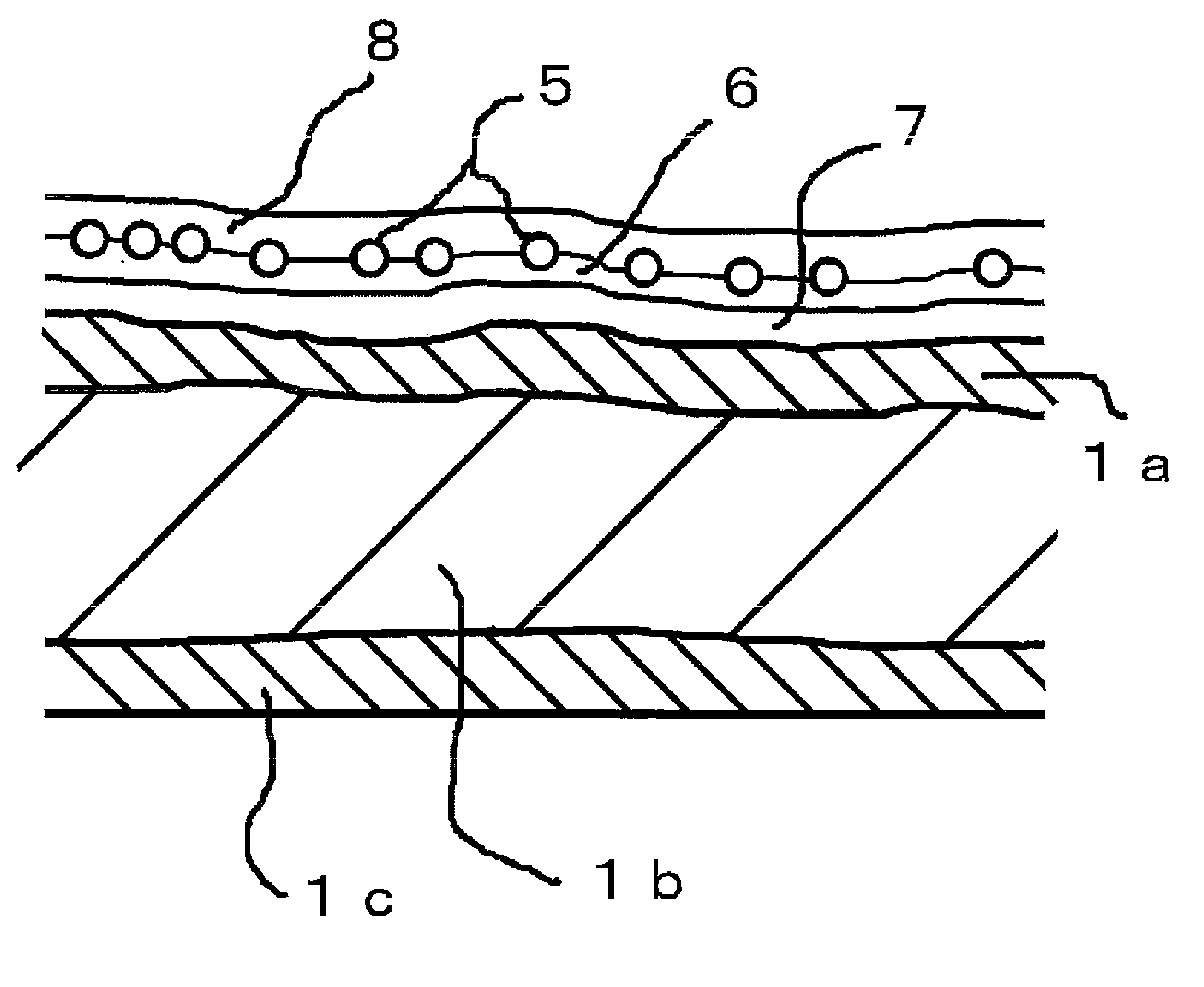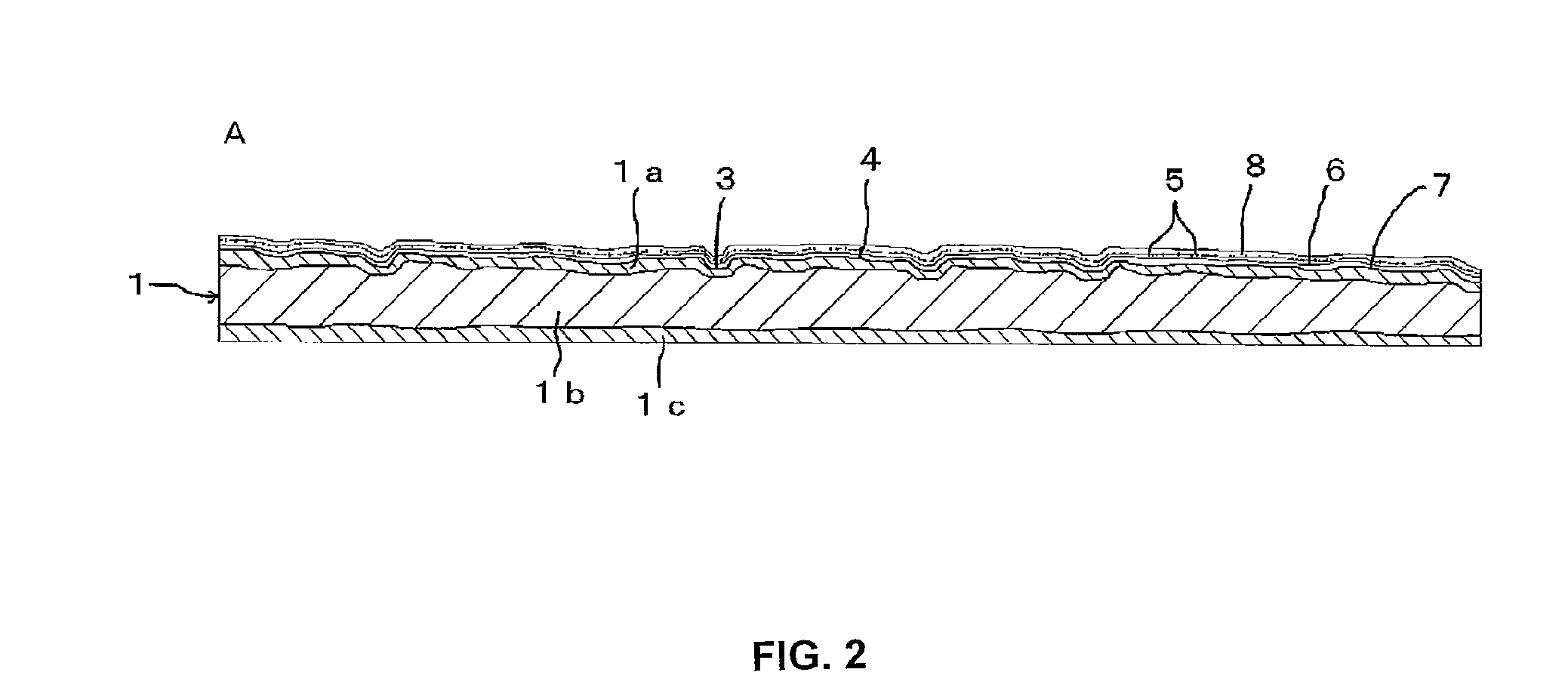[0010]JP 2005-088463A, which relates to an inorganic decorative board formed by performing semi-dry forming and then
autoclave curing of a semi-dry composition containing
cement and a wood material as main ingredients, provides a colored inorganic decorative board and a manufacturing method therefor. According to JP 2005-088463A, a color
pigment and a bleached pulp serving as the wood material are mixed in a semi-dry composition that constitutes at least a surface portion, thereby preventing a
stain-like unevenness of color from occurring in part of a colored
surface layer after
autoclave treatment. Thus, even in the case where a conventional color painting step is omitted, a considerable degradation in the surface appearance can be avoided, and the above-mentioned
stain-like unevenness of color can be prevented from occurring on the colored surface layer while maintaining the advantageous effects of mixing a wood material with
cement, i.e., weight reduction, reinforcement, and good
formability of an inorganic mat.
[0011]An inorganic base board has complex, minute recesses like a
burrow, and such recesses can decrease the adhesion of the base board to a finishing transparent paint layer and the waterproof properties or cause
efflorescence after construction. However, conventionally, this problem has been concealed by applying an opacifying paint containing a large amount of pigments, such as a pigmented
enamel paint, and has not become manifest. JP 2005-238075A proposes a method for manufacturing an inorganic decorative building board in which the surface of an inorganic base board is coated with a finishing transparent paint to allow the color of the surface of the base board to appear on the surface of the building board. In the proposed method, in order to satisfactorily fill the
burrow-like, complex recesses that are present on the surface of a
cement base board without loss of the transparency so that the adhesion of the base board to the transparent paint layer, the waterproof property, the
efflorescence resistance, and the like can be improved, the surface of the cement base board after autoclave curing is coated with an undercoating transparent paint in which fine particles are mixed with a resin solution that, after hardening and becoming a hardened body, has transparency, the fine particles maintain the transparency of the resin of the hardened body, and the finishing transparent paint is applied onto the undercoating transparent paint.
[0012]In the case where an inorganic board is obtained by shaping a composition in which cement, a wood material, and a color pigment are mixed using a semi-dry forming method, and the inorganic board is hardened by autoclave curing, a
stain-like unevenness of color can occur in part of the surface of a colored substrate layer after autoclave treatment. If a color painting step that has conventionally been performed on a surface layer is omitted, the unevenness of color on the colored substrate layer will remain on the surface, and so it has been extremely difficult to avoid such an unevenness of color on the colored substrate that considerably degrades the surface appearance. Furthermore, in the case where a base board whose substrate has been colored is cured in an autoclave, the
color tone of the colored substrate layer changes depending on a combination of factors including the
color tone of the cement, the color tone of the wood
fiber, the color tone of silica sand, the external environmental conditions during manufacture, and the control conditions of the autoclave. However, it also has been difficult to completely control this change in color tone.
[0013]Meanwhile, with a method of dispersing an ornamental powdery or granular material onto the colored substrate layer before the formation of a design face, press forming for the formation of the design face causes the ornamental powdery or granular material to be embedded halfway into the top surface of the substrate. Furthermore, the press forming causes differences in the density of the dispersed ornamental powdery or granular material between flat and inclined portions of the design face. Therefore, in order to obtain sufficient decorativeness to satisfactorily express the natural non-uniformity and look of natural materials that are possessed by stone,
ceramic tiles, and the like, improvements in the conformity of such an ornamental powdery or granular material to a pattern and further improvements in, for example, techniques for creating a subtle texture individually for each design piece have been desired.SUMMARY OF THE INVENTION
[0014]A first aspect in accordance with the present invention provides a decorative building board including a colored substrate layer and an ornamental powdery or granular material, the decorative building board having sufficient decorativeness to satisfactorily express the natural non-uniformity and look of natural materials that are possessed by stone,
ceramic tiles, and the like, as well as reduced unevenness of color in the substrate and change in the color tone of the colored substrate layer that occur during autoclave curing and excellent
weathering resistance, and a method for manufacturing the decorative building board with improved productivity, and to thereby manufacture a building board including a colored substrate that creates a natural
atmosphere that painting techniques do not, as an industrial product with a steady quality.
[0015]In a second aspect in accordance with the present invention, a primary sealer is applied at a stage before autoclave curing, and a powdery or granular material fixing sealer is applied after autoclave curing to fix an ornamental powdery or granular material.
 Login to View More
Login to View More 


